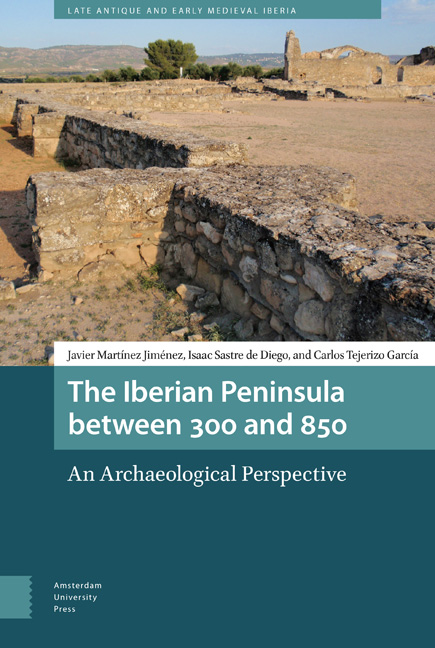Book contents
- Frontmatter
- Contents
- List of Figures
- Acknowledgements
- Preliminary notes
- Preface
- Introduction: An archaeological perspective on the Iberian peninsula between Rome and the Middle Ages
- Part 1 The Late Roman period
- Part 2 The post-Roman period
- Part 3 The Early Middle Ages
- Appendix 1 Site reference table
- Appendix 2 Maps
- Appendix 3 Lists of rulers
- Abbreviations
- Bibliography
- Index
2 - New townscapes in the late Empire
Published online by Cambridge University Press: 10 December 2020
- Frontmatter
- Contents
- List of Figures
- Acknowledgements
- Preliminary notes
- Preface
- Introduction: An archaeological perspective on the Iberian peninsula between Rome and the Middle Ages
- Part 1 The Late Roman period
- Part 2 The post-Roman period
- Part 3 The Early Middle Ages
- Appendix 1 Site reference table
- Appendix 2 Maps
- Appendix 3 Lists of rulers
- Abbreviations
- Bibliography
- Index
Summary
This chapter will analyse the formal and material changes that affected Iberian towns in the late Roman period. By the fourth century the urban landscapes were saturated with monuments. After three centuries of construction there was, understandably, an end to large building projects, because of the walls, aqueducts, baths, theatres, amphitheatres, etc., that were already built. Furthermore, Roman culture had slowly drifted away from old patterns. For instance, late Roman society preferred horse races in the circus and venationes over traditional theatre plays, while gladiatorial combats were becoming both too expensive and less popular; the lack of public interest causing the buildings linked to them to begin a period of decline. This, together with the political-administrative transformations outlined in the previous chapter, meant that there was a change in public priorities which, slowly, began to lay the foundations of the Late Antique town model, which would be in existence throughout the late and post- Roman periods (cf. Diarte Blasco 2014).
What constituted a late Roman city?
Theoretical approaches, based on historical analyses and inter-regional comparisons across the Empire of late Roman urbanism, can be used to define this concept of ‘late Roman city’, in sharp contrast with the ‘classical’ or ‘early Roman city’.
In the last 20 years, the interest in Late Antique urbanism, especially after the proposals of Liebeschuetz (esp. 1992; cf. Dey 2014), has developed greatly, so that it is now almost a discipline in its own right. The definition of the ‘late Roman city’ model is, nevertheless, not straight forward and there are various possible interpretations (as we have defined and described elsewhere: Martínez and Tejerizo 2015: 83-5). In the Codex Iustinianus (I.3.35), a town was defined by the presence of a bishop (Brandes 1999: 27) but, archaeologically, there are other parameters. Bryan Ward-Perkins (1996:4-14) defined a town as having administrative and religious functions, together with some more quantitative characteristics such as size, status, urban planning and significant public and private buildings. This definition was largely kept by Gian Pietro Brogiolo (1999: 99), who defined a town as fulfilling legal, military, ecclesiastical, economic, and administrative functions. In his definition there are two main characteristics: a) towns are part of a wider political context (the Roman state) but, and at the same time, b) have some autonomy in terms of local administration.
- Type
- Chapter
- Information
- The Iberian Peninsula between 300 and 850An Archaeological Perspective, pp. 67 - 100Publisher: Amsterdam University PressPrint publication year: 2018



